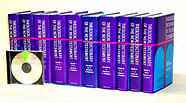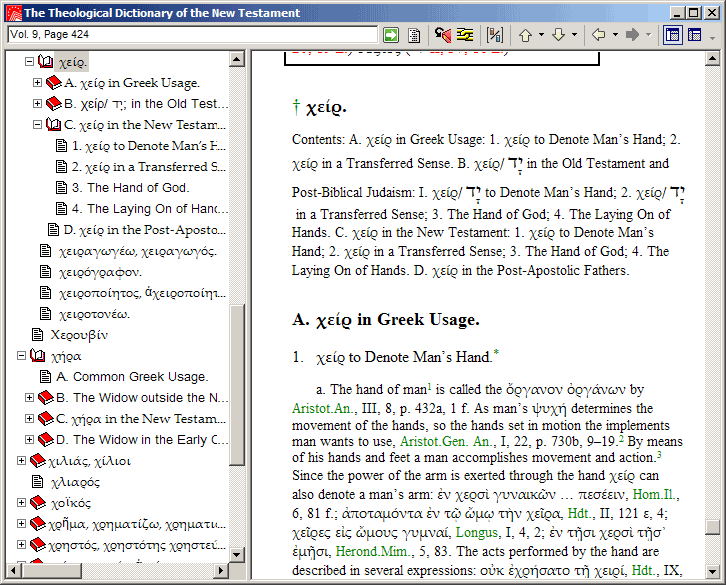 Unabridged
Theological Dictionary of the New Testament
Unabridged
Theological Dictionary of the New TestamentOne of the most
widely-used and well-respected theological dictionaries ever created, TDNT
is indispensible for studies in the Greek New Testament. Words were selected
for inclusion in this dictionary based on their theological significance.
The historical development and theological nuances of each word are
exhaustively explored. The authors trace usage in classical Greek literature,
the Old Testament (LXX) and extrabiblical texts, and New Testament passages.
As you can see, TDNT ("Big Kittel") is a massive reference work. The
abridged 1,392-page version of TDNT is available as an unlock and is
included with Scholar's Library. The full unabridged 9,081-page version is
also included with Scholar's Library...or can be purchased separately here.
Preface to the Electronic
Edition of TDNT
The Theological Dictionary of the New Testament (TDNT) is one of the few
agreed upon standard reference works in the area of New Testament studies.
The depth and breadth of the information contained within the pages of the
ten-volume print edition are well worth the cost, weight, and shelf space
that they require.
However, in the 70 years since the first volume was originally published in
German, significant advances have been made in the areas of information
storage and retrieval. Technology has progressed to the point where entire
libraries can be accessed electronically. Therefore, there is no better time
for the timeless information contained within the ten print volumes that
make up the Theological Dictionary of the New Testament to be released in a
Logos Bible Software compatible electronic edition.
Enhancements of the
Electronic Edition
This electronic edition has several enhancements that make TDNT more
usable than it has ever been before. While the ten-volume print edition has
been useful mainly to scholars of classical and New Testament Greek, this
electronic version offers many enhancements that increase usability for both
the scholar and the astute Bible student. These enhancements come in a
number of areas:
- Abbreviations, a commonly cryptic element of most theological works,
can now be clicked upon and the user will be provided with the full
abbreviation definition from the abbreviation table.
- References to both The Works of Philo and The Works of Josephus are
enabled. Therefore, if versions of Philo or Josephus are available to
the user, these valuable cross references can be examined in their
complete context.
- The indices of volume ten have been implemented as topic indices
within the Logos Library System. Specifically:
- The Index Greek Keywords included information that associates
Strongs’ numbers with Greek articles. This information is implemented as
a topic index. This allows the user to use a Strongs-number enabled New
Testament (such as the King James Version or New American Standard
Bible, 1995 Edition) to access the information in TDNT from a Strongs
number.
- Individual Greek article headwords are included as topics in both
Greek and Greek Lemma languages. This allows the user to use the Keylink
functionality to jump to articles in TDNT from a morphologically tagged
Greek text.
- The Index of English Keywords is also available. This allows the
user to search TDNT in English for a given topic and arrive at the
relevant Greek articles.
- The Contributor and Co-Worker Index is also available. A
comprehensive list of articles from a contributor is available simply by
clicking on the author citation at the end of each article.
- The Index of Biblical References is comprehensive in this electronic
version. Using the Reference Search functionality, one can arrive at a
complete listing of instances where a particular verse is referenced
throughout the whole of the TDNT.
- All Bible references are enabled, allowing the user to click upon a
Bible reference to look up the reference in a preferred translation. In
addition, discrepancies in versification are automatically dealt with.
So, when a verse reference to the Septuagint (LXX) is made, any
versification differences are implicitly rectified when the search
results are reported back to the user.
- Article references by either article name or by volume and page are
enabled as well. This allows the user to examine the numerous instances
where a given article refers the user to another article within TDNT for
clarification and expansion on a given topic or idea.
Of course, the normal benefits of a Logos Bible Software compatible
electronic book are available as well. The entire text is searchable by
language. The layout and presentation of the printed edition are preserved
as much as possible. Most important, however, is the fact that TDNT can now
be used in conjunction with other electronic books within the single
standardized interface of the Libronix Digital Library System.
Supplementary Enhancements to Other Logos Bible Software Compatible
Electronic Books
In addition to the TDNT itself, enhancements have been made to other
Logos Bible Software compatible electronic books that contain links to TDNT.
Enhanced Strongs Lexicon and the
Theological Dictionary of the New Testament, Abridged
in One Volume (also known as "Little Kittel" or TDNTA) both
contain information that link these texts to TDNT.
Each article in the TDNTA contains a citation to the volume and page of the
TDNT article from which it was abridged. These volume and page links have
been enabled as hypertext jumps. Therefore, one now may link to the fuller
treatment of a given article in the TDNT from the abridgement in the TDNTA.
The portion of the Enhanced Strongs Lexicon that represents the Greek
language includes volume and page references to the TDNT for selected
articles. These references are enabled, so that the user may now jump from
Strongs to TDNT via hypertext link. In addition, some articles also refer
the user to the TDNTA page number for more information. These references are
enabled as well.
Conclusion
The venerable Theological Dictionary of the New Testament becomes even
more usable when it is digitized. The above mentioned enhancements allow the
student of today to use TDNT in ways that the contributors and editors of
the information may have never anticipated. In short, it allows students,
pastors, and laypersons alike the opportunity to significantly increase
their knowledge of New Testament Greek and allow this newfound linguistic
knowledge to play a role in their study, teaching, and application of the
New Testament message.
R. Brannan
July 2000

| Стоимость CD-ROM: 15 у.е. |



